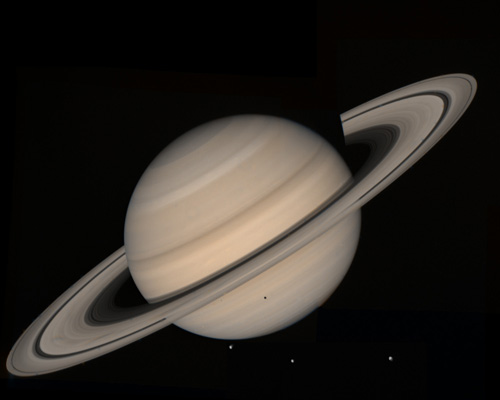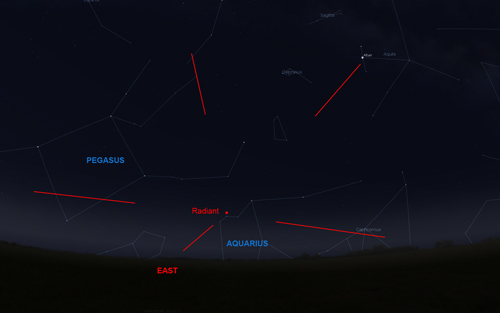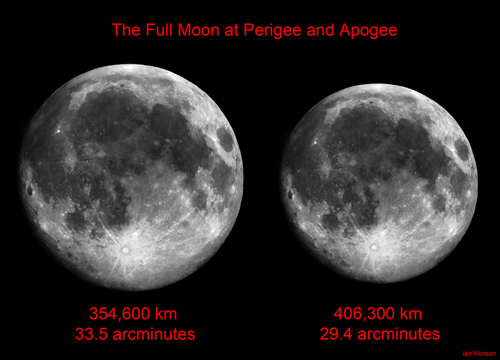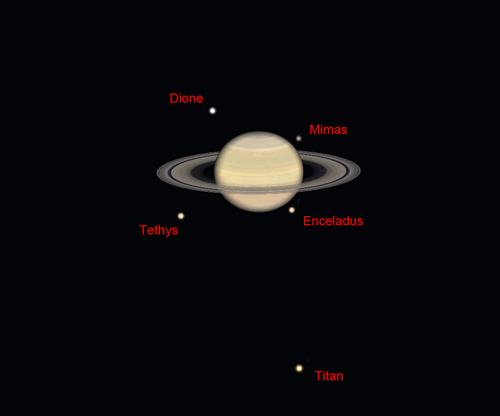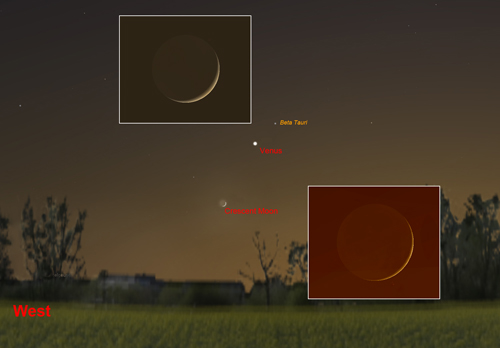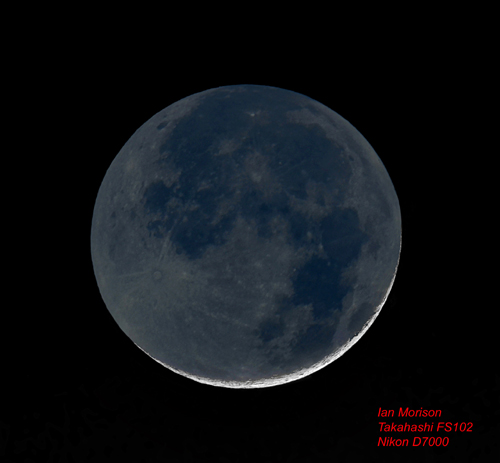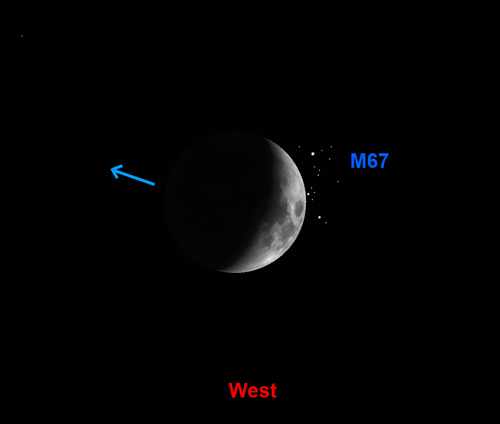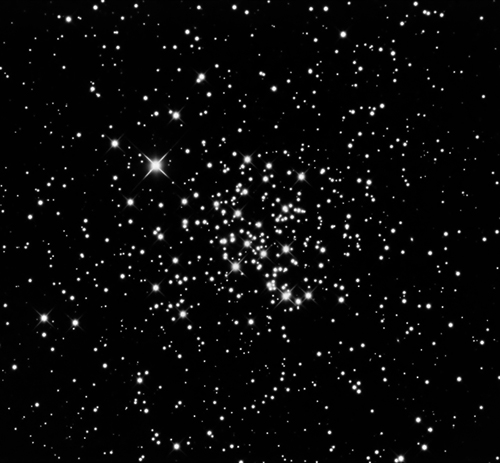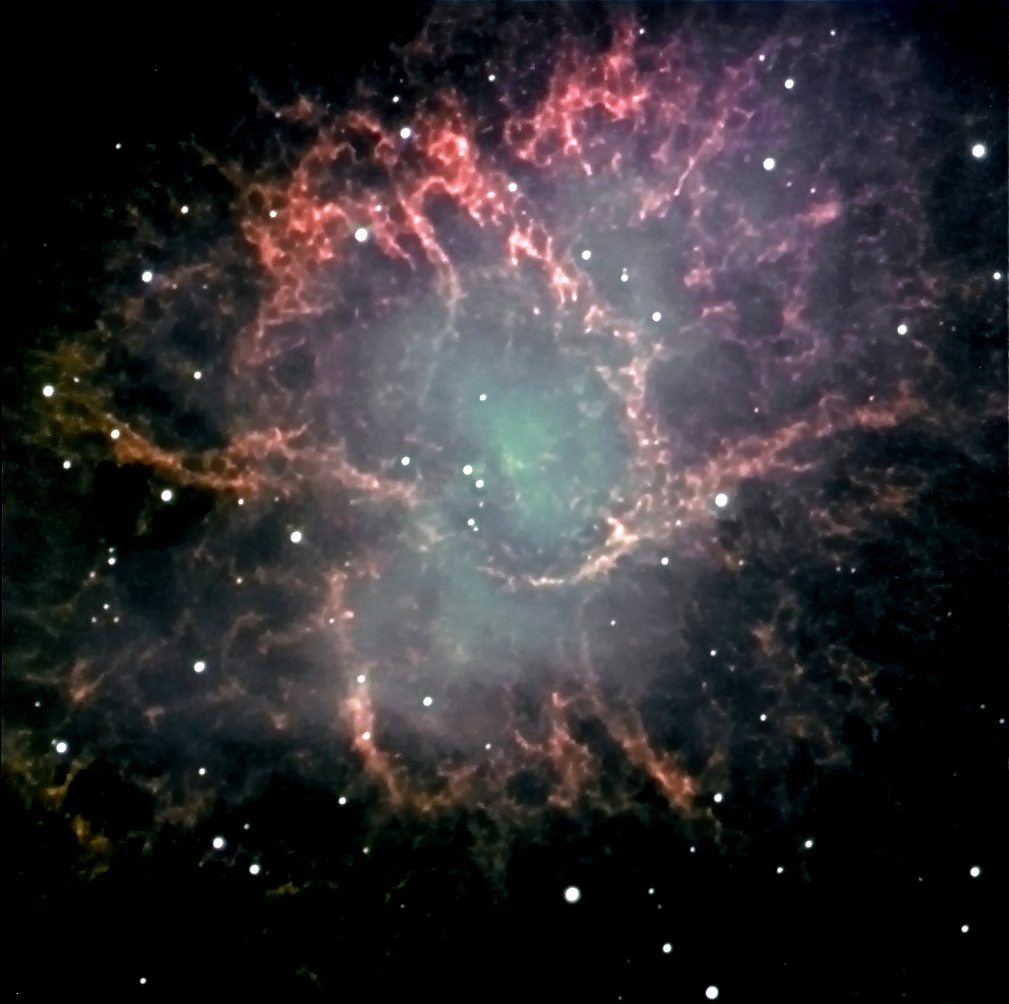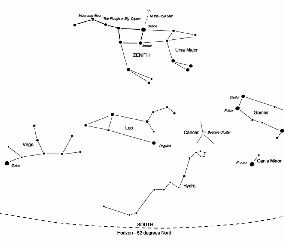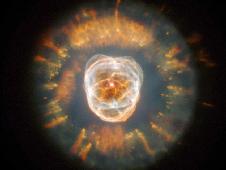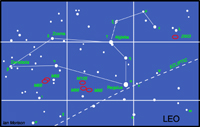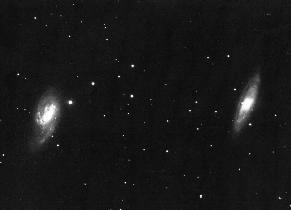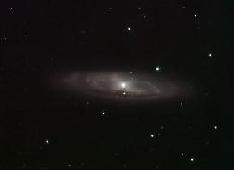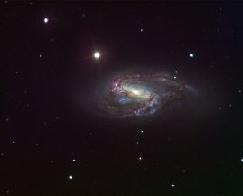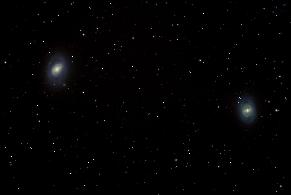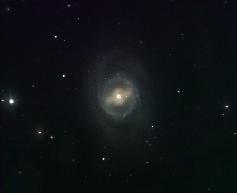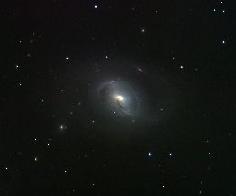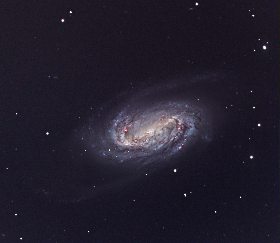The Night Sky May 2012
Compiled by Ian Morison
Saturn in ascendant
This page, updated monthly, will let you know some of the things that you can look out for in the night sky. It lists the phases of the Moon, where you will see the naked-eye planets and describes some of the prominent constellations in the night sky during the month.
Image of the Month
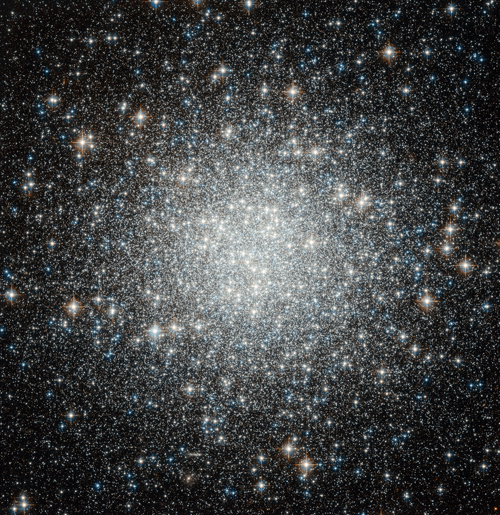
Globular Cluster M53
ESA/Hubble, NASA
This Hubble image of Messier 53 is, I think, the best image of a globular cluster I have ever seen. It is one of the furthest out of the ~250 globular clusters that lie in the galactic halo and can be seen with binoculars in the constellation Coma Berenices. It contains over 250,000 stars most of which are older and redder than our Sun. This is to be expected as globular clusters are thought to have been formed along with our Milky Way galaxy. However this image shows quite a number of young blue stars - known as Blue Stragglers - which contradict the perceived wisdom that all stars in a globular cluster were born at the same time. It is now thought that they are old stars which have been rejuvenated by fresh matter falling on them from a binary star companion and their abundance in globular clusters can be used to estimate their age.
Highlights of the Month
May: Observe Saturn in the evening sky
To see some of Damian Peache's Saturn Images: Damian Peache's website
Saturn is now in the southern sky during the evening. It lies in the constellation Virgo close to the its brightest star Spica. The rings are now ~13 degrees from the line of site and so Saturn appears brighter than for a couple of years, but it will not be until 2018 that they will be at their widest again. It is one of the most beautiful objects in the heavens and though you will never see all the detail that is shown in the Cassini images - or even those made by Damian Peache - your first view of Saturn and its rings will never be forgotten. It takes Saturn 29.4 years to complete one orbit. Due to the tilt of its rotation axis, for half this time we see the northern hemisphere best and for the other half the southern hemisphere. Following the time when we saw the rings edge on a year or so ago, we are now seeing the northern hemisphere. Though not as prominent as those in Jupiter's atmosphere, there are belts and zones in the which can be seen. The belts are thought to be warmer gasses low down in the atmosphere whilst the brighter zones are thought to be ice crystals and clouds in the upper, colder, atmosphere. A small telescope will show the two brightest rings, the outer A ring and the closer in B or Bright ring. These are separated by Cassini's Division. With a ~8" aperture telescope and a night of good seeing, one may also spot Encke's division towards the outer edge of the A ring. A small telescope will also easily show its largest moon, Titan. See further details below in the "Planets" section.
May 6th before dawn: The Eta Aquarid Meteor Shower
Looking East-Southeast well before dawn on the morning of May 6th and given a good low horizon in that direction you you be able to spot some of the meteors that are part of the Eta Aquarid meteor shower. As it is so close to full Moon, moonlight (though from the other side of the sky) is likely to hide many of the ~25 meteors per hour that might be seen from our northerly latitude. The Eta Aquarids result from dust particles that were released from Comet Halley in an eruption as it neared the Sun some 4,000 years ago.
May 5th/6th : The closest and brightest Full Moon for 100 years!
At 1 am on the 6th May, the full Moon transits (lies due south) at which time its distance from the centre of the Earth will be 356,954 km. This is the closest Full Moon to the Earth since January 1912. It will thus appear larger in the sky than at any time since then. This is because the Moon has an elliptical orbit and thus its distance from the Earth varies by about 12%. The image shows how this effects the apparent size of the Moon in the Sky - its quite surprising! When the Moon is closest, called "at Perigee" it can, of course, have any phase from new to full. On the 5th/6th May Perigee corrisponds very closely with Full Moon - hence its large apparent size. At transit, the UK (on the Earth's surface) will be somewhat closer and the diagram gives the distance - 354,600 km - from us. Hopefully, we will be able to see the Moon as it rises at ~8:15 BST on the evening of the 5th when the "Moon Illusion" will make it appear very big. The cause of this illusion is disputed, but many believe that it is due to the fact that we perceive the sky as forming a flattened, rather than a hemispherical, dome above us. We thus believe that objects near the horizon are further away and our minds make them appear larger than when we "believe" that we are seeing them closer to us.
Occasions when the Full Moon is close to perigee occur about every 412 days, so are not that rare. At this time the angular diameter of the Moon exceeds 33 arc minutes and its diameter is 12% larger than when at apogee. This makes the apparent area around 30% greater than when we see the full Moon close to apogee. Quite a difference!
May 20th: Saturn and its moons
On the 20th April with no Moon in the sky and a reasonable sized telescope there is a nice grouping of the satellites of Saturn to be seen in the late evening. Even the smallest of telescopes will show 9th magnitude Titan.
May 22nd: Two very thin crescents - Venus and a nearly new Moon.
After sunset on the 22nd, you may, given a low western horizon and clear skies, be able to spot Venus at magnitude -4.5 above a thin crescent Moon. It is rare that you will be able to see two such thin cresents at one time! Look out for the "earthshine" illuminating the "dark side" of the Moon - often called the "old Moon in the new Moon's arms".
May 26th: The Moon occults the open cluster M67
On the 26th May the waxing crescent Moon passes over the position of the open cluster M67 in the constellation of Cancer, the Crab. Sadly the event - from ~9pm until ~11pm BST - occurs when the Moon will be low in the west. Observations when the cluster stars are first occulted will be hindered by the sky brightness, but their reappearance at the bright limb of the Moon around 11pm BST should be visible if clear. Binoculars or a small telesocpe will be needed to see the stars. The further south and east your location in the UK, the better.
A Messier Object imaged with the Faulkes Telescope: Messier 1 - the Crab Nebula in Taurus.
the Crab Nebula, M1, imaged by Nik Szymanek.
This image was taken using the Faulkes Telescope North by Nik Szymanek - one of the UK's leading astro-photograpers. Details about the Crab Nebula are given in the Taurus section of the "Astronomical A List" (Link upper left of this page). In this lovely image, the Crab Pulsar is the lower right of the pair of bright "stars" near the centre of the image. It is an easy winter telescope object given a moonless and transparent sky away from towns and cities.
Learn more about the Faulkes Telescopes and how schools can use them: Faulkes Telescope"
Observe the International Space Station

The International Space Station and Jules Verne passing behind the Lovell Telescope on April 1st 2008.
Image by Andrew Greenwood
Use the link below to find when the space station will be visible in the next few days. In general, the space station can be seen either in the hour or so before dawn or the hour or so after sunset - this is because it is dark and yet the Sun is not too far below the horizon so that it can light up the space station. As the orbit only just gets up the the latitude of the UK it will usually be seen to the south, and is only visible for a minute or so at each sighting. Note that as it is in low-earth orbit the sighting details vary quite considerably across the UK. The NASA website linked to below gives details for several cities in the UK. (Across the world too for foreign visitors to this web page.)
Note: I observed the ISS three times recently and was amazed as to how bright it has become.
Find details of sighting possibilities from your location from: Location Index
See where the space station is now: Current Position
The Moon

The Moon at 3rd Quarter. Image, by Ian Morison, taken with a 150mm Maksutov-Newtonian and Canon G7.
Just below the crator Plato seen near the top of the image is the mountain "Mons Piton". It casts a long shadow across the maria from which one can calculate its height - about 6800ft or 2250m.
| new moon | first quarter | full moon | last quarter |
|---|---|---|---|
| May 21st | May 28th | May 6th | May 12th |
Some Lunar Images by Ian Morison, Jodrell Bank Observatory: Lunar Images
A World Record Lunar Image
To mark International Year of Astronomy, a team of British astronomers have made the largest lunar image in history and gained a place in the Guinness Book of Records! The whole image comprises 87.4 megapixels with a Moon diameter of 9550 pixels. This allows details as small as 1km across to be discerned! The superb quality of the image is shown by the detail below of Plato and the Alpine Valley. Craterlets are seen on the floor of Plato and the rille along the centre of the Alpine valley is clearly visible. The image quality is staggering! The team of Damian Peach, Pete lawrence, Dave Tyler, Bruce Kingsley, Nick Smith, Nick Howes, Trevor Little, David Mason, Mark and Lee Irvine with technical support from Ninian Boyle captured the video sequences from which 288 individual mozaic panes were produced. These were then stitched together to form the lunar image.
Please follow the link to the Lunar World Record website and it would be really great if you could donate to Sir Patrick Moore's chosen charity to either download a full resolution image or purchase a print.
The Planets
Jupiter
Jupiter passes behind the Sun on May 13th - superior conjunction - so will not be visible until the very end of the month when it rises just 45 minutes before dawn and could be glimpsed (at magnitude -2) with binoculars just above the eastern horizon.
Saturn
Saturn reached opposition on April 15th and is now seen about 25 degrees above the eastern horizon after sunset and will be in the south around midnight BST. It will then have an elevation of some 33 degrees and lie about 5 degrees up and to the left of the first magnitude star Spica as it moves westwards across the sky in "retrograde" motion through the constellation Virgo. Its magnitude drops from +0.3 to +0.5 as May progresses whilst its angular size also falls - from 19 to 18.4 arc seconds. Sadly, in contrast to Jupiter, Saturn is heading to the more southerly parts of the ecliptic so, for quite some considerable time, will not be seen high above the horizon from our northern climes. However the rings have opened out nicely and are now ~13 degrees to the line of sight, so will appear appreciably wider than we have seen during its last apparition. It is now well be worth having a look at its 19 arc second disk and ring system. With a small telescope on a night of good seeing, you should be able to easily spot Cassini's Division within the ring system, and given a scope with an aperture of 6 inches or greater and a night of excellent seeing one might even spot Encke's division in the outer A-ring and also the inner, elusive, C-ring.
Mercury
Mercury, is barely visible low above the eastern horizon as May begins and might just be glimpsed with binoculars just 5 degrees above the horizon at Sunrise shining at magnitude zero. It rapidly disappears from view as it reaches superior conjunction (lying behind the Sun) on the 27th May.
Mars
Mars, lying below the body of Leo, the Lion, is still, at the beginning of May, some 60 degrees above the western horizon an hour after sunset. Moving further away from us, its magnitude fades from -0.1 to to +0.5 during the month as it moves westwards, increasing its distance from Regulus from 6 to 15 degrees. At the same time its angular diameter shrinks from 10 arc seconds down to 8 arc seconds but, given a night of good seeing it may still be possible to see some markings on the surface.
Venus
Venus, is still dominating the south-western sky after sunset. Its angular separation from the Sun at the start of the month is ~39 degrees and, at sunset, will be ~34 degrees above the horizon. As May begins it is at its brigtest - magnitude -4.7 - as, on April 30th, it achieved it "greatest illuminated extent" - the largest apparent illuminated area with a disk 38 arc seconds across which is ~27% illuminated. However as Venus moved towards the Earth - with its apparent angular size increasing to 57 arc seconds by months end - it rapidly closes towards the Sun and so will only have an elevation of 6-7 degrees at sunset. In the last week of May, the thin crescent should easily be visible in binoculars and it is said tht keen eyed observers may even spot this with their unaided eyes. Why not have a try?
It might just be pointed out that at inferrior conjunction on the 6th June Venus passes in front of the Sun - the second, and last, Venus Transit this century!
See highlight above.
Find more planetary images and details about the Solar System: The Solar System
The Stars
The evening May Sky
This map shows the constellations seen in the south after sunset.
The constellation Gemini is now setting towards the south-west and Leo holds pride (sic) of place in the south with its bright star Regulus. Between Gemini and Leo lies Cancer - which is well worth observing with binoculars to see the Beehive Cluster at its heart. Below Gemini is the tiny constellation Canis Minor whose only bright star is Procyon. Rising in the south-east is the constellation Virgo whose brightest star is Spica. Though Virgo has few bright stars it is in the direction of of a great cluster of galaxies - the Virgo Cluster - which lies at the centre of the supercluster of which our local group of galaxies is an outlying member. High overhead in the north is the constellation Ursa Major which also contains many interesting objects.
The constellation Gemini
Gemini - The Twins - lies up and to the left of Orion and is in the south-west during early evenings this month. It contains two bright stars Castor and Pollux of 1.9 and 1.1 magnitudes respectivly. Castor is a close double having a separation of ~ 3.6 arc seconds making it a fine test of the quality of a small telescope - providing the atmospheric seeing is good! In fact the Castor system has 6 stars - each of the two seen in the telescope is a double star, and there is a third, 9th magnitude, companion star 73 arcseconds away which is alos a double star! Pollux is a red giant star of spectral class K0. The planet Pluto was discovered close to delta Geminorum by Clyde Tombaugh in 1930. The variable star shown to the lower right of delta Geminorum is a Cepheid variable, changing its brightness from 3.6 to 4.2 magnitudes with a period of 10.15 days
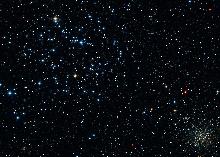
M35 and NGC 2158
This wonderful image was taken by Fritz Benedict and David Chappell using a 30" telescope at McDonal Observatory. Randy Whited combined the three colour CCD images to make the picture
M35 is an open star cluster comprising several hundred stars around a hundred of which are brighter than magnitude 13 and so will be seen under dark skies with a relativly small telescope. It is easily spotted with binoculars close to the "foot" of the upper right twin. A small telescope at low power using a wide field eyepiece will show it at its best. Those using larger telescopes - say 8 to 10 inches - will spot a smaller compact cluster NGC 2158 close by. NGC 2158 is four times more distant that M35 and ten times older, so the hotter blue stars will have reached the end of their lives leaving only the longer-lived yellow stars like our Sun to dominate its light.
To the lower right of the constellation lies the Planetary Nebula NGC2392. As the Hubble Space Telescope image shows, it resembles a head surrounded by the fur collar of a parka hood - hence its other name The Eskimo Nebula. The white dwarf remnant is seen at the centre of the "head". The Nebula was discovered by William Herschel in 1787. It lies about 5000 light years away from us.
The constellation Leo
The constellation Leo is now in the south-eastern sky in the evening. One of the few constellations that genuinely resembles its name, it looks likes one of the Lions in Trafalger Square, with its manem and head forming an arc (called the Sickle) to the upper right, with Regulus in the position of its right knee. Regulus is a blue-white star, five times bigger than the sun at a distance of 90 light years. It shines at magnitude 1.4. Algieba, which forms the base of the neck, is the second brightest star in Leo at magnitude 1.9. With a telescope it resolves into one of the most magnificent double stars in the sky - a pair of golden yellow stars! They orbit their common centre of gravity every 600 years. This lovely pair of orange giants are 170 light years away.
Leo also hosts two pairs of Messier galaxies which lie beneath its belly. The first pair lie about 9 degrees to the west of Regulus and comprise M95 (to the east) and M96. They are almost exactly at the same declination as Regulus so, using an equatorial mount, centre on Regulus, lock the declination axis and sweep towards the west 9 degrees. They are both close to 9th magnitude and may bee seen together with a telescope at low power or individually at higher powers. M65 is a type Sa spiral lying at a distance of 35 millin klight years and M66, considerably bigger than M65, is of type Sb. Type Sa spirals have large nuclei and very tightly wound spiral arms whilst as one moves through type Sb to Sc, the nucleus becomes smaller and the arms more open.
The second pair of galaxies, M95 and M96, lie a further 7 degrees to the west between the stars Upsilon and Iota Leonis. M95 is a barred spiral of type SBb. It lies at a distance of 38 million light years and is magnitude 9.7. M96, a type Sa galaxy, is slightly further away at 41 million light years, but a little brighter with a magnitude of 9.2. Both are members of the Leo I group of galaxies and are visible together with a telescope at low power.
There is a further ~9th magnitude galaxy in Leo which, surprisingly, is in neither the Messier or Caldwell catalogues. It lies a little below lambda Leonis and was discovered by William Herschel. No 2903 in the New General Catalogue, it is a beautiful type Sb galaxy which is seen at somewhat of an oblique angle. It lies at a distance of 20.5 million light years.
The constellation Virgo
Virgo, rising in the east in late evening this month, is not one of the most prominent constellations, containing only one bright star, Spica, but is one of the largest and is very rewarding for those with "rich field" telescopes capable of seeing the many galaxies that lie within its boundaries. Spica is, in fact, an exceedingly close double star with the two B type stars orbiting each other every 4 days. Their total luminosity is 2000 times that of our Sun. In the upper right hand quadrant of Virgo lies the centre of the Virgo Cluster of galaxies. There are 13 galaxies in the Messier catalogue in this region, all of which can be seen with a small telescope. The brightest is the giant elliptical galaxy, M87, with a jet extending from its centre where there is almost certainly a massive black hole into which dust and gas are falling. This releases great amounts of energy which powers particles to reach speeds close to the speed of light forming the jet we see. M87 is also called VIRGO A as it is a very strong radio source.
Below Porrima and to the right of Spica lies M104, an 8th magnitude spiral galaxy about 30 million light years away from us. Its spiral arms are edge on to us so in a small telescope it appears as an elliptical galaxy. It is also known as the Sombrero Galaxy as it looks like a wide brimmed hat in long exposure photographs.
The constellation Ursa Major
The stars of the Plough, shown linked by the thicker lines in the chart above, form one of the most recognised star patterns in the sky. Also called the Big Dipper, after the soup ladles used by farmer's wives in America to serve soup to the farm workers at lunchtime, it forms part of the Great Bear constellation - not quite so easy to make out! The stars Merak and Dubhe form the pointers which will lead you to the Pole Star, and hence find North. The stars Alcor and Mizar form a naked eye double which repays observation in a small telescope as Mizar is then shown to be an easily resolved double star. A fainter reddish star forms a triangle with Alcor and Mizar.
Ursa Major contains many interesting "deep sky" objects. The brightest, listed in Messier's Catalogue, are shown on the chart, but there are many fainter galaxies in the region too. In the upper right of the constellation are a pair of interacting galaxies M81 and M82 shown in the image below. M82 is undergoing a major burst of star formation and hence called a "starburst galaxy". They can be seen together using a low power eyepiece on a small telescope.
Another, and very beautiful, galaxy is M101 which looks rather like a pinwheel firework, hence its other name the Pinwheel Galaxy. It was discovered in1781 and was a late entry to Messier's calalogue of nebulous objects. It is a type Sc spiral galaxy seen face on which is at a distance of about 24 million light years. Type Sc galaxies have a relativly small nucleus and open spiral arms. With an overall diameter of 170,000 light it is one of the largest spirals known (the Milky Way has a diameter of ~ 130,000 light years).
Though just outside the constellation boundary, M51 lies close to Alkaid, the leftmost star of the Plough. Also called the Whirlpool Galaxy it is being deformed by the passage of the smaller galaxy on the left. This is now gravitationally captured by M51 and the two will eventually merge. M51 lies at a distance of about 37 million light years and was the first galaxy in which spiral arms were seen. It was discovered by Charles Messier in 1773 and the spiral structure was observed by Lord Rosse in 1845 using the 72" reflector at Birr Castle in Ireland - for many years the largest telescope in the world.
Lying close to Merak is the planetary nebula M97 which is usually called the Owl Nebula due to its resemblance to an owl's face with two large eyes. It was first called this by Lord Rosse who drew it in 1848 - as shown in the image below right. Planetary nebulae ar the remnants of stars similar in size to our Sun. When all possible nuclear fusion processes are complete, the central core collpses down into a "white dwarf" star and the the outer parts of the star are blown off to form the surrounding nebula.


